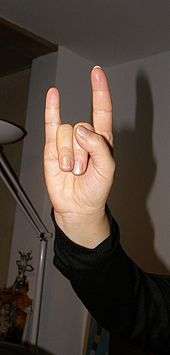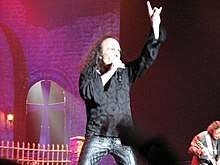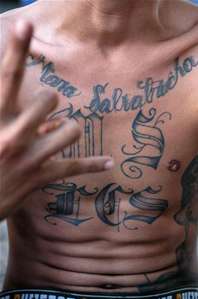Sign of the horns
The sign of the horns is a hand gesture with a variety of meanings and uses in various cultures. It is formed by extending the index and little fingers while holding the middle and ring fingers down with the thumb.

Spiritual and superstitious meaning
In Hinduism, the hand gesture is known as the "Apana yogic mudra".[1] In Indian classical dance forms the hand gesture symbolises the Lion[1]. In Buddhism it is seen as an apotropaic gesture very commonly used by Gautama Buddha as "Karana Mudra" which is synonymous with expulsion of demons and removal of obstacles like sickness or negative thoughts.[1]
The apotropaic usage of the sign can also be seen in Italy and in other Mediterranean cultures where, when confronted with unfortunate events, or simply when these events are mentioned, the sign of the horns may be given to ward off further bad luck. It is also used traditionally to counter or ward off the "evil eye" (malocchio in Italian). In Italy specifically, the gesture is known as the corna. With fingers pointing down, it is a common Mediterranean apotropaic gesture, by which people seek protection in unlucky situations (it is thus a more Mediterranean equivalent of knocking on wood). Thus, for example, the President of the Italian Republic, Giovanni Leone, shocked the country when, while in Naples during an outbreak of cholera, he shook the hands of patients with one hand while with the other behind his back he superstitiously made the corna, presumably to ward off the disease or in reaction to being confronted by such misfortune. This act was well documented by the journalists and photographers who were right behind him, a fact that had escaped President Leone's mind in that moment.
In Italy and other parts of the Mediterranean region, the gesture must usually be performed with the fingers tilting downward to signify the warding off of bad luck; in the same region and elsewhere, the gesture may take a different, offensive and insulting meaning if it is performed with fingers upward or if directed aggressively towards someone in a swiveling motion (see section below). In Italy, one can also "touch iron" (tocca ferro) or touch one's nose to ward off bad luck. Males in Italy may also grab their testicles when confronted by bad luck; however, this is considered more vulgar.
In Peru one says contra (against). In the Dominican Republic the expression is zafa, said against curses known as fukú. All of these gestures are meant to conjure supernatural protection.
The sign of the horns is used during religious rituals in Wicca, to invoke or represent the Horned god.[2]
Offensive gesture
In many Mediterranean and Latin countries, such as Brazil, Greece, Italy, Portugal, Spain, Mexico[3][4][5][6] when directed towards someone and swiveled back and forth, the sign implies cuckoldry; the common words for cuckolded in Italian, Greek and Spanish are cornuto, κερατάς (keratas) and cornudo, respectively, literally meaning "horned".[7] During a European Union meeting in February 2002, then-current Italian prime minister Silvio Berlusconi was photographed performing this gesture behind the back of Josep Piqué, the Spanish foreign minister.[8]
Northwestern European and North American popular culture
Contemporary use by musicians and fans
The 1969 back album cover for Witchcraft Destroys Minds & Reaps Souls on Mercury Records by Chicago-based psychedelic-occult rock band Coven, led by singer Jinx Dawson, pictured Coven band members giving the "sign of the horns". Starting in early 1968, Coven concerts always began and ended with Dawson giving the sign on stage.
On the cover of the Beatles' Yellow Submarine album (1969), the cartoon of John Lennon's right hand is making the sign above Paul McCartney's head. Some fans interpreted this as one of the many supposed "Paul is dead" clues. Some may think it is possible that the cartoonist misrepresented the sign for "I love you", which is very similar and more in keeping with the band's public message and image. However, the 1969 cartoon is based on many photos of John Lennon making the hand sign in 1967. One of these photos of Lennon doing the hand sign appears on the cover of a Beatles single release shortly after, making it the first time the hand sign appears on a rock release.
The sign is also used in various Disney movies. It can be seen in the medieval-style opening sequence of the 1971 British-American Disney movie Bedknobs and Broomsticks, when a goat-legged figure with a jester's cap who is leading a procession of outlandish-looking figures, flashes the sign.
Beginning in the early 1970s, the horns were known as the "P-Funk sign" to fans of Parliament-Funkadelic. It was used by George Clinton and Bootsy Collins as the password to the Mothership,[9] a central element in Parliament's science-fiction mythology, and fans used it in return to show their enthusiasm for the band. Collins is depicted showing the P-Funk sign on the cover of his 1977 album Ahh... The Name Is Bootsy, Baby!
Frank Zappa can be seen jokingly making the gesture in the 1979 film Baby Snakes in response to the audience, commenting, "That's right, spindle twice."
In 1977, a painting of Gene Simmons (of the band KISS) exhibits the sign on the cover of Love Gun, the band's sixth studio album. Simmons still utilizes the sign, both on and off stage.
Marlon Brando makes the sign whilst singing "Luck Be a Lady" in the 1955 film Guys and Dolls, seeming to indicate it was a sign for snake eyes in the craps game he is playing for the gamblers' souls.[10]
In the 1985 film, The Breakfast Club, Richard "Dick" Vernon is the grumpy vice principal of Shermer High School and the main antagonist of the film. One of his most famous lines is, "Don't mess with the bull young man, you'll get the horns", flashing the sign of the horns while rotating his wrist.
In one episode of the popular animated series The Simpsons, a female tramp is seen warding off a male tramp using the sign of the horns using her thumbs and index fingers, screaming 'And you're a three-headed devil dog! Devil dog!'
For the 2016 Indian movie Rock On 2, The "2" in the title is stylized with the sign of the horns, with the two extended fingers representing "2".
Heavy metal culture

Ronnie James Dio was known for popularizing the sign of the horns in heavy metal.[9][11] He claimed his Italian grandmother used it to ward off the evil eye (which is known in Southern Italy as malocchio). Dio began using the sign soon after joining the metal band Black Sabbath in 1979. The previous singer in the band, Ozzy Osbourne, was rather well known for using the "peace" sign at concerts, raising the index and middle finger in the form of a V. Dio, in an attempt to connect with the fans, wanted to similarly use a hand gesture. However, not wanting to copy Osbourne, he chose to use the sign his grandmother always made.[12] The horns became famous in metal concerts very soon after Black Sabbath's first tour with Dio. The sign would later be appropriated by heavy metal fans under the name "maloik", a corruption of the original malocchio.
Terry "Geezer" Butler of Black Sabbath can be seen "raising the horns" in a photograph taken in 1971. The photograph is included in the CD booklet of the Symptom of the Universe: The Original Black Sabbath 1970–1978 compilation album. This would indicate that there had been some association between the "horns" and heavy metal before Dio's popularization of it.
When asked if he was the one who introduced the hand gesture to metal subculture, Dio said in a 2001 interview with Metal-Rules.com:
I doubt very much if I would be the first one who ever did that. That's like saying I invented the wheel, I'm sure someone did that at some other point. I think you'd have to say that I made it fashionable. I used it so much and all the time and it had become my trademark until the Britney Spears audience decided to do it as well. So it kind of lost its meaning with that. But it was … I was in Sabbath at the time. It was a symbol that I thought was reflective of what that band was supposed to be all about. It's NOT the devil's sign like we're here with the devil. It's an Italian thing I got from my Grandmother called the "Malocchio". It's to ward off the Evil Eye or to give the Evil Eye, depending on which way you do it. It's just a symbol but it had magical incantations and attitudes to it and I felt it worked very well with Sabbath. So I became very noted for it and then everybody else started to pick up on it and away it went. But I would never say I take credit for being the first to do it. I say because I did it so much that it became the symbol of rock and roll of some kind.[13]
Gene Simmons of the rock group KISS attempted to claim the "devil horns" hand gesture for his own. According to CBS News, "Simmons filed an application on Friday, June 16, 2017 with the U.S. Patent and Trademark Office for a trademark on the hand gesture he regularly uses during concerts and public appearances — thumb, index and pinky fingers extended, with the middle and ring fingers folded down. According to Simmons, this hand gesture was first used in commerce — by him — on Nov. 14, 1974. He is claiming the hand gesture should be trademarked for "entertainment, namely live performances by a musical artist [and] personal appearances by a musical artist."[14] Simmons abandoned this application on June 21, 2017.[15]
Electronic communication
In text-based electronic communication, the sign of the horns is represented with the \../, \m/ or |m| emoticon and sometimes with /../. The Unicode character U+1F918 🤘 SIGN OF THE HORNS was introduced in Unicode 8.0 as an emoji, on June 17, 2015.[16]
Gang hand signal
The "sign of the horns" hand gesture is used in criminal gang subcultures to indicate membership or affiliation with Mara Salvatrucha. The significance is both the resemblance of an inverted "devil horns" to the Latin letter 'M', and in the broader demonic connotation, of fierceness and nonconformity.

Sports culture

Hook 'em Horns is the slogan and hand signal of the University of Texas at Austin. Students and alumni of the university employ a greeting consisting of the phrase "Hook 'em" or "Hook 'em Horns" and also use the phrase as a parting good-bye or as the closing line in a letter or story. The gesture is meant to approximate the shape of the head and horns of the UT mascot, the Texas Longhorn Bevo.
Fans of the University of South Florida Bulls use the same hand sign at their athletic events, except that the hand is turned around and facing the other way. With the middle and ring finger extending towards the person presenting the "Go Bulls" sign.
Fans of North Dakota State University Bison athletics also use a similar hand gesture, known as "Go Bison!" The pinky and index fingers are usually slightly bent, however, to mimic the shape of a bison's horns.
Fans of North Carolina State University Wolfpack athletics use a similar gesture with the middle and ring fingers moving up and down over the thumb to mimic a wolf's jaw.
Fans of University of California, Irvine Anteaters use a similar sign with the middle and ring fingers out to resemble the head of the mighty anteater.
Fans of University of Nevada, Reno Wolf Pack athletics use a similar sign with the middle and ring fingers out to resemble the wolf's snout.
A variation of this hand gesture is also used in the professional wrestling industry, which fans dub the "Too Sweet". It was possibly innovated by Scott Hall and the other members of The Kliq based on the Turkish Grey Wolves (organization) organization hand gesture according to Sean Waltman, and has since been attributed to other wrestling groups such as the nWo and Bullet Club, as well as individual wrestlers such as Finn Bálor.
Fans of University of Utah athletics, particularly football and gymnastics, use a gesture where the index and pinky finger are straight and parallel to each other, forming a block "U."[17]
Fans of Northwestern State University Demon athletics also use a similar hand gesture, known as "Fork 'em!" The pinky and index fingers are extended but a little more parallel to each other resembling the horns on a demon.
Arizona State University Sun Devil fans make a pitchfork sign by extending the index and middle fingers, as well as the pinky. The thumb holds down the ring finger to complete the gesture.
Fans of the Wichita State University Shockers frequently hold up their middle finger in addition to the pointer and pinky fingers as a reference to the comic sexual act.
Fans of the Grand Canyon University Antelopes use this hand gesture with a slight variation by touching the tips of the ring and middle finger with the thumb to form the shape of an antelope and its horns. Often followed by the phrase "Lopes up".
Fans of the Universidad de Chile soccer team use this gesture to represent their support for the team by forming a U-shaped hand gesture, often followed by the phrase "Grande la U".
Fans of University at Buffalo Buffalo Bulls athletics uses the same hand sign at their athletic events. This gesture is meant to resemble a bull's horns.
See also
- ILY sign is sometimes confused with this gesture because many users tend to do the "horns" improperly by extending their thumb.
- Shaka sign
- Cornicello
References
- "Is Rajinikanth's party symbol the same as Apana Mudra for 'detoxification and purification'?". January 4, 2018.
- Wicca: A Guide for the Solitary Practitioner by Scott Cunningham, p. 42.
- "Rude hand gestures of the world (don't try these on holiday)". February 4, 2016 – via www.telegraph.co.uk.
- "International field guide to rude hand gestures". Archived from the original on 2013-12-14.
- "Hand Gestures in Different Cultures".
- Lefevre, Romana (2011-10-21). Rude Hand Gestures of the World: A Guide to Offending without Words By Romana Lefevre. ISBN 9781452110172.
- "Hand Gestures Part Two — The Cuckold Gesture". Reading-Body-Language.co.uk.
- "Top 10 Worst Silvio Berlusconi Gaffes". 8 December 2012. Retrieved 21 May 2017 – via content.time.com.
- Appleford, Steve (September 9, 2004). "Odyssey of the Devil Horns". Los Angeles City Beat. Archived from the original on November 22, 2007.
A friend arranges a meeting with Clinton. I hand him a photograph of Dio making the hand signal, and tell him this is the man (or one of them) credited with bringing it to rock. Clinton stares at the picture for a long, silent minute, breathing heavily. Another minute passes. He's never heard of Ronnie James Dio. It's the P-Funk sign, man.
- "Marlon Brando-Luck Be a Lady". youtube.com. Retrieved 13 September 2017.
- "The Devil's Horns: A Rock And Roll Symbol". Ultimate-Guitar.com. September 7, 2005.
- Ronnie James Dio interview in the 2005 documentary Metal: A Headbanger's Journey. In the interview he also ridicules Gene Simmons for taking credit for originating use of the sign in heavy metal, attributing the claim to Simmons' well-known egotism.
- "Dio - Interviewed By EvilG". Metal-Rules.com. March 9, 2001.
- "Gene Simmons wants to trademark "devil horns" hand gesture". CBS News. June 15, 2017.
- "Gene Simmons Abandons Hand Gesture Trademark Application". Forbes. June 21, 2017.
- ""Burrito," "Sign Of The Horns," and 35 other emoji approved in Unicode 8.0". Retrieved 21 May 2017.
- "MUSS - Student Cheer Section for the U of U Utes - University of Utah Alumni Association | MUSS". Alumni.utah.edu. 2011-03-18. Retrieved 2012-08-13.
External links
| Wikimedia Commons has media related to Sign of the horns. |
- Rock and Roll Confidential on their logo
- Haverty, Neil (2002-05-30). "Ronnie James Dio Re-Claims the Devil Horns". Chart. Archived from the original on 2009-10-03. Retrieved 2009-09-27.
- President George W. Bush, gestures the "Hook 'em, horns," the salute of the University of Texas Longhorns.(...)
- Odyssey of the Devil Horns: Who is responsible for bringing metal's famous hand signal to the tribe? Los Angeles CityBeat, Sept. 9, 2004